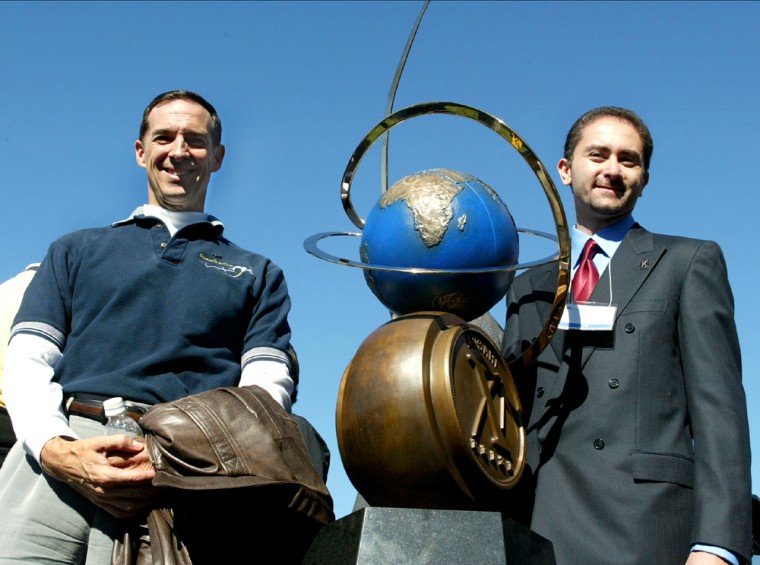Marking the end of a years-long quest, the team behind the SpaceShipOne rocket plane on Saturday accepted the $10 million Ansari X Prize for advancements in private space travel and tourism.
The prize was awarded in St. Louis to Mojave Aerospace Ventures, a group formed by famed aerospace designer Burt Rutan and software billionaire Paul Allen. With the $10 million as an incentive, Rutan and his California-based team spent the past three years developing their system for sending private astronauts on suborbital space trips, with SpaceShipOne launched from a carrier airplane in midflight.
SpaceShipOne reached an altitude of 62.5 miles (100 kilometers) in June, marking the first spaceflight in a privately developed craft. On Sept. 29 and Oct. 4, the rocket plane hit that height two more times, fulfilling the requirements for the prize.
On Saturday, the SpaceShipOne team received the 5-foot-high, 200-pound-plus (1.5-meter high, 100-kilogram) X Prize trophy as well as an oversized check written for eight figures. Among those in attendance at the ceremony, conducted next to the St. Louis Science Center, were Rutan, Allen and the pilots for each of the prize-winning flights, Mike Melvill and Brian Binnie.
"How can a day like today be anything but wonderful when you get a $10 million check?" Rutan said.
Rutan said the X Prize recognized more than just a space plane.
"I feel particularly proud that what we did in winning this prize was not just to build an airplane to fly high enough, but to address the safety issues and the affordability issues for space tourism," he told the crowd.
Top innovations
Later, in a telephone interview from the St. Louis Science Center, he listed three significant innovations for MSNBC.com:
- SpaceShipOne's pivoting-wing system, which allows for "carefree re-entry" from space, without the need for the pilot to touch the controls during the crucial transition back to atmospheric flight.
- A patented configuration for the space plane's hybrid rocket motor that boosted the system's safety by providing "only one leak path" for the rocket propellant.
- An air-launch system for piloted spaceflight, which Rutan said was far safer than conventional ground-launched rockets. "We don't think that ground-launched rockets are going to be safe enough unless there's some paradigm shift that makes them significantly more robust than they always have been," Rutan told MSNBC.com.
Such safety innovations would be essential if private space travel is to become a profitable venture, he said.
"You can't have a space tourism business unless you have enormous increases in safety. If you count the people who have been outside the atmosphere, 4 percent of them have died flying outside the atmosphere, and you certainly can't have a spaceflight where you kill 4 percent of your customers," Rutan told MSNBC.com.
Allen has spent in excess of $20 million chasing the $10 million prize, but he and Rutan hope to earn more money back as the private spaceflight market grows. Already, they have struck a deal with Virgin Group founder Richard Branson for a five-plane fleet of commercial "SpaceShipTwos" that could begin service in 2007.
Eight-year effort
The X Prize, first offered in 1996, was modeled after the $25,000 Orteig Prize for trans-Atlantic aviation, which was won in 1927 by Charles Lindbergh in his "Spirit of St. Louis" plane. Like Lindbergh's flight, the prize won its initial backing from St. Louis business leaders.
"Eight years ago, we stood here and said one day someone is going to do something no one's ever done before," said Doug King, president of the St. Louis Science Center.
Eventually, a $1 million-plus contribution from Anousheh and Amir Ansari, Iranian-American entrepreneurs who made their fortune in the telecommunications industry, enabled the X Prize Foundation to buy a $10 million "hole-in-one" insurance policy to back the potential purse.
At the St. Louis ceremony, Amir Ansari said the prize has helped “usher in a new era” in aviation.
More than two dozen teams worldwide began projects in hopes of winning the X Prize, and X Prize founder Peter Diamandis says his foundation wants to offer a fresh incentive for such groups by organizing the X Prize Cup competition — a "Grand Prix of space" to be held in New Mexico, beginning with a demonstration event next year.
Diamandis' group is also working with the World Technology Network to create a new set of prizes for technological innovation, called the WTN X Prizes.
This report includes information from The Associated Press.
